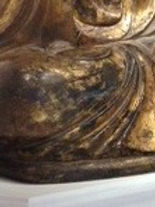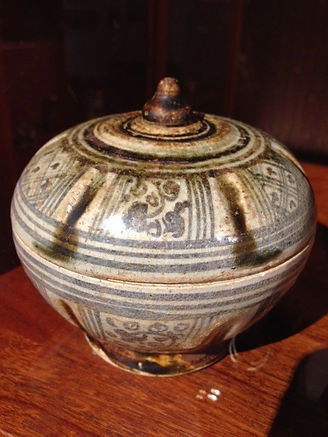
All art seen can be found at the Harn Museum in Gainesville, FL.



Since bronze is made of a combination of copper and other metals such as tin, aluminum, manganese, or even zinc, it is pretty resistant to microbes and is therefore difficult to deteriorate by biological means. However, judging by this artifact, we get a different impression. The flask seems to suffer from many stains and has lost most of its green color. Due to its extremely old age, the damage done to this flask could possibly be due to a combination of both biological and non-biological mechanisms. In a previous study, researchers were able to isolate yeasts from a bronze statue (1), which makes me believe that the microbes that played a role in this particular case were also yeasts. The best prevention for fungal contamination of art in museums seems to be climate control, regular cleaning, and microbiological monitoring (2). If left in an environment with high humidity or other undesirable conditions, the fate of this artifact could take more of a downfall and result in complete loss of its bronze color.
(1) https://www.ncbi.nlm.nih.gov/pmc/articles/PMC2227722/#r44
(2)https://www.researchgate.net/publication/230577503_Fungi_Their_Role_in_Deterioration_of_Cultural_Heritage



This sculpture has lost some of its gold color and seems to have patches of different shades of grey and black stains on it. Upon researching effects of microbes on artifacts of similar nature, I came upon a study that inspected a wooden sculpture covered with polychrome for microbes (3). Since this sculpture is also made out of the same material, I believe that the same microbes could have played a role in their deterioration. According to the study, the two dominant bacteria isolated were Bacillus sp. and Streptomyces sp. It was also suggested that wooden structures be treated with a solution containing 180mgl of methyl-isothiazolone PBK. Temperature and moisture control are also vital in prevention of many microbial organisms and therefore should also be controlled by the museum. The fact that the sculpture is not contained within a glass box could also lead to humidity from human breath and more exposure to microbes through humans.
(3) http://www.jstor.org/stable/1506879?seq=1#page_scan_tab_contents Since



This lidded box made of stoneware, which is a "hard, opaque, vitrified ceramic ware" (4). It shows blackish-brown growths and deterioration. I believe the bacteria that might have caused these damages to this lidded box are sulfur-oxidizing bacteria of Acidithiobacillus genus. Two species, A. thiooxidans and A. ferrooxidans, are especially known for deterioration of stoneware through corrosion due to the considerable acidifying they perform on stoneware (4). The bacterial growth can be stopped through regulation of humidity and temperature in the museum. If no prevention occurs, unfortunately many pieces of art like this one could face excessive damage. The fact that the stoneware is preserved behind glass also shows a step taken by the museum to prevent damage of all sorts. It also prevents humidity that could be transferred through means such as human breath.